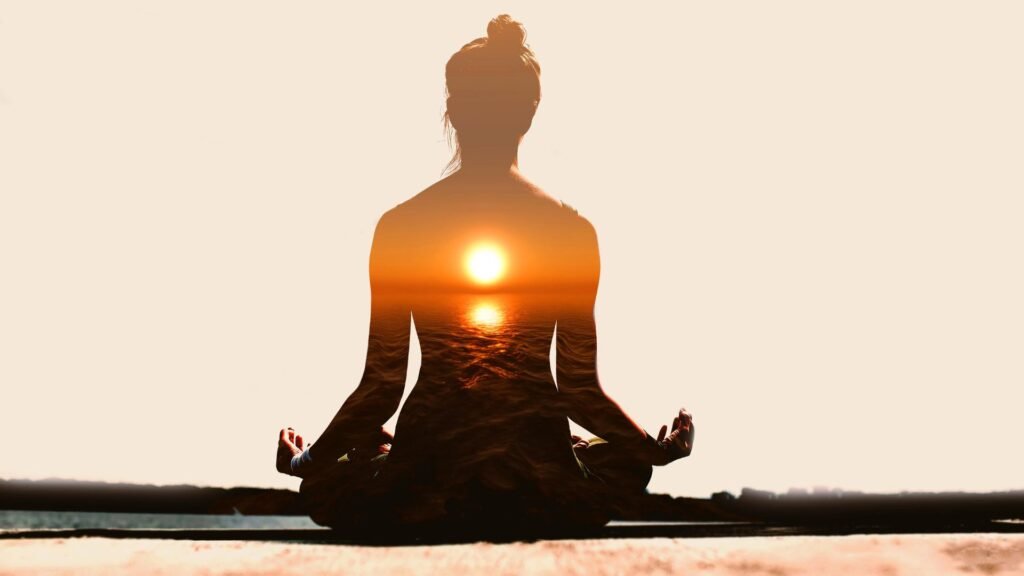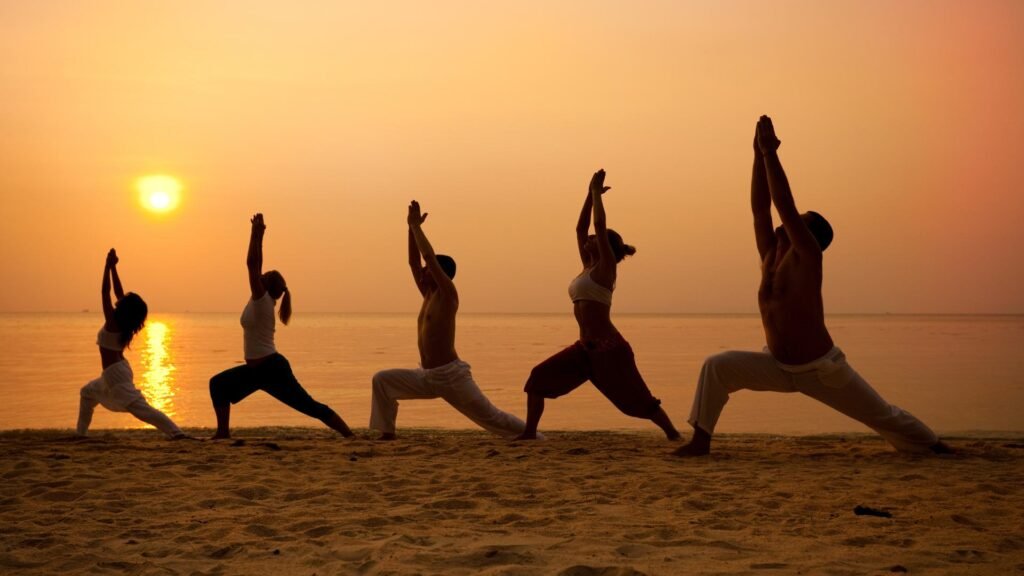Yoga, an ancient practice originating in India, has gained immense popularity in recent years for its numerous physical, mental, and spiritual benefits. Beyond the physical postures and poses, yoga offers a holistic approach to well-being, integrating mind, body, and spirit. This article will explore the hidden benefits of yoga and how this transformative practice can improve your overall quality of life.
Physical Benefits of Yoga

One of the most well-known benefits of yoga is its positive impact on physical health. Regular practice of yoga can improve strength, flexibility, and balance. The various asanas or poses target different muscle groups, helping to tone and sculpt the body. Additionally, yoga promotes better posture and alignment, reducing the risk of chronic pain and injuries. As a low-impact exercise, yoga is suitable for people of all ages and fitness levels.
Yoga also improves cardiovascular health by increasing blood circulation and oxygenation. This gentle form of exercise can lower blood pressure and reduce the risk of heart disease. Furthermore, yoga has been shown to enhance the functioning of the immune system, improving overall health and well-being.
Mental and Emotional Benefits of Yoga
Yoga not only improves physical health, but also positively affects mental and emotional health. The deep breathing techniques and meditation practiced during yoga sessions help to calm the mind and reduce stress. Regular yoga practice has been shown to decrease levels of the stress hormone cortisol, leading to improved mental clarity and a greater sense of calm.
Yoga is also an effective tool for managing anxiety and depression. The combination of movement, breathwork, and mindfulness cultivates a state of relaxation and promotes a positive outlook. Studies have shown that yoga can increase levels of serotonin, the “feel-good” neurotransmitter, and improve overall mood.
Moreover, yoga can enhance cognitive function and improve focus and concentration. The mind-body connection fostered during yoga practice enhances mental clarity and promotes a sense of mindfulness and presence.
Spiritual Benefits of Yoga
Beyond the advantages to the body and mind, yoga has a strong spiritual foundation. Yoga provides a path to connect with one’s inner self and tap into a higher consciousness. Through the practice of meditation and self-reflection, yoga cultivates a sense of spiritual awareness and inner peace.
Yoga teaches us to live in the present moment and embrace the interconnectedness of all beings. It encourages self-acceptance, compassion, and gratitude. By aligning our actions with our values and embracing a yogic lifestyle, we can experience profound spiritual growth and transformation.
Read More : Understanding Alzheimer’s Disease: Symptoms, Medication, And Treatment Options
Yoga For Women – Specific Benefits and Considerations

Yoga offers unique benefits for women, addressing specific physical and emotional needs. Regular practice of yoga can alleviate menstrual discomfort and hormonal imbalances. Certain poses, such as forward bends and gentle twists, can help ease cramps and promote a healthy menstrual cycle.
Prenatal yoga is also highly beneficial for expectant mothers. It helps to strengthen the pelvic floor, improve circulation, and reduce pregnancy-related discomfort. Prenatal yoga classes provide a supportive environment for women to connect with their changing bodies and prepare for childbirth.
Additionally, yoga can aid in postpartum recovery by strengthening the core, improving posture, and relieving stress. It offers a gentle and nurturing practice for new mothers, promoting physical and emotional healing.
It is important for women to listen to their bodies and make modifications as needed during yoga practice. Pregnancy and certain health conditions may require adjustments to ensure a safe and enjoyable experience. Consulting with a qualified yoga instructor can help women tailor their practice to their specific needs and goals.
Is Yoga a Good Workout? Exploring the Physical Intensity of Yoga
While yoga may not have the same reputation for intense physical workouts as activities like running or weightlifting, it can certainly be a challenging and effective form of exercise. The physical intensity of yoga varies depending on the style and level of practice.
Dynamic styles such as Vinyasa or Power Yoga involve flowing sequences of poses, providing a cardiovascular workout that builds strength and endurance. These styles can be particularly beneficial for those looking for a more vigorous physical practice.
On the other hand, gentle styles such as Hatha or Yin Yoga focus on holding poses for longer periods, allowing for deep stretching and relaxation. These styles promote flexibility, balance, and a sense of calm.
Flexibility, balance, and coordination are all improved. It helps to improve flexibility, balance, and coordination. By incorporating both strength and flexibility, yoga offers a well-rounded approach to fitness.
How Yoga Improves Flexibility and Range of Motion

Flexibility is a key component of yoga practice, and consistent practice can significantly improve range of motion. The various stretches and postures in yoga target different muscle groups, promoting lengthening and loosening of tight muscles.
As we age, our muscles tend to become less flexible, leading to stiffness and decreased range of motion. Yoga helps to counteract this natural process by increasing the elasticity of muscles and connective tissues. Over time, regular yoga practice can lead to noticeable improvements in flexibility and joint mobility.
Yoga also improves proprioception, which is the body’s ability to perceive its position in space. This increased body awareness enhances coordination and balance, reducing the risk of falls and injuries.
Incorporating a variety of poses that target different muscle groups is key to maximizing flexibility gains. A well-rounded yoga practice includes forward bends, backbends, twists, side stretches, and inversions, allowing for a comprehensive stretch of the entire body.
Incorporating Yoga into Your Daily Routine – The Benefits of Daily Practice
Practicing yoga daily offers numerous benefits for both the body and mind .To experience the benefits of yoga, consistency is essential. A regular daily practice helps to build strength, flexibility, and endurance over time.
By making yoga a part of your daily routine, you create a dedicated time for self-care and mindfulness. This can have a profound impact on stress reduction and overall well-being. The act of carving out time for yourself each day sends a powerful message of self-love and self-nurturing.
Moreover, daily yoga practice allows you to deepen your understanding of the practice and explore new aspects of your physical and mental capabilities. It offers a chance for introspection and personal development.
The best way to incorporate yoga into your daily routine is to choose a consistent time and create a dedicated space for practice. Whether it is in the morning, during lunch breaks, or in the evening, finding a time that works best for you ensures that yoga becomes an integral part of your daily life.
The Best Time to Practice Yoga – Morning, Evening, or Anytime?
Individual interests and schedules ultimately determine the ideal time to practice yoga. Some people find that practicing yoga in the morning sets a positive tone for the rest of the day. It can help to awaken the body and mind, providing a boost of energy and mental clarity.
Others prefer to practice yoga in the evening as a way to unwind and release tension from the day. Evening yoga can promote relaxation and prepare the body for a restful night’s sleep.
Ultimately, the best time to practice yoga is the time that works best for you and allows for consistency. Whether it is in the morning, evening, or any other time of the day, the important thing is to make it a regular part of your routine.
How Long Should You Practice Yoga Each Day? Exploring the Benefits of Different Time Durations
The duration of your daily yoga practice depends on your goals, preferences, and available time. Even a short practice of 10 to 20 minutes can offer benefits, especially when done consistently.
If you are looking to build strength and flexibility, a longer practice of 60 to 90 minutes can be beneficial. This allows for a more comprehensive exploration of different poses and sequences.
However, if time is limited, a shorter practice can still be effective. A 30-minute practice can provide a well-rounded session that includes warm-up, asanas, and relaxation. The key is to prioritize consistency and make the most of the time you have available.
Remember, yoga is a practice of self-care, and it is important to listen to your body’s needs. Some days you may feel energized and able to engage in a longer practice, while other days a shorter practice may be more appropriate. Flexibility in both the body and the practice itself is key.
Yoga as a Holistic Practice – Integrating Mind, Body, and Spirit
What sets yoga apart from other forms of exercise is its holistic approach. Yoga is more than just physical postures; it is a practice that integrates mind, body, and spirit. The physical poses, breathing techniques, and meditation work together to create a deeply transformative experience.
The asanas or poses help to strengthen and tone the body, improving physical health and vitality. The pranayama or breathwork cultivates a deep connection with the breath, promoting relaxation and mental clarity. The practice of meditation allows for self-reflection and inner stillness, nurturing the spirit.
By integrating these three aspects, yoga creates a harmonious balance within us. It helps to align our thoughts, actions, and emotions, fostering a sense of wholeness and well-being. This holistic approach sets yoga apart as a truly transformative practice.
The Power of Breathwork in Yoga – Enhancing the Benefits of the Practice
Breathwork, or pranayama, is a fundamental aspect of yoga practice. The breath is considered the bridge between the mind and body, and conscious breathing can have a profound impact on our physical and mental well-being.
Deep breathing techniques used in yoga help to calm the nervous system and reduce stress. The parasympathetic nerve system, which is in charge of the body’s relaxation response, is triggered by taking slow, deep breaths. This promotes a state of calm and relaxation, reducing anxiety and tension.
Breathwork also enhances the physical benefits of yoga. By consciously directing the breath to different parts of the body, we can increase oxygenation and energy flow. This allows for a deeper stretch and release of tension in the muscles.
Furthermore, breathwork cultivates mindfulness and presence. By focusing on the breath, we bring our attention to the present moment, letting go of worries and distractions. This enhances the meditative aspect of yoga practice, promoting a sense of inner peace and clarity.
Yoga as a Form of Meditation – Cultivating Mindfulness and Inner Peace

Yoga and meditation are deeply intertwined, and the practice of yoga can be seen as a form of moving meditation. The physical postures and breathwork serve as a gateway to cultivating mindfulness and inner peace.
During yoga practice, the mind is encouraged to focus on the present moment – the sensations in the body, the rhythm of the breath. This creates a state of flow and absorption, similar to the state achieved during seated meditation.
The practice of mindfulness in yoga allows us to observe our thoughts and emotions without judgment or attachment. We learn to cultivate a sense of detachment from the fluctuations of the mind, creating space for clarity and insight.
Regular yoga practice can help enhance the quality of sleep, which is frequently disturbed by stress and anxiety. It provides a sanctuary from the busyness of daily life, allowing us to find stillness and peace within.
Yoga for Stress Relief and Relaxation
Stress has ingrained itself into our daily lives in the fast-paced world of today. Yoga offers a powerful antidote to stress, providing a sanctuary for relaxation and rejuvenation.
The combination of physical movement, breathwork, and mindfulness during yoga practice helps to activate the body’s relaxation response. This counteracts the effects of the stress response, which can lead to physical and mental health problems.
Yoga poses such as forward bends, gentle twists, and inversions help to release tension in the body and promote relaxation. The deep breathing techniques used in yoga activate the parasympathetic nervous system, reducing the production of stress hormones and inducing a state of calm.
Regular practice of yoga can also improve sleep quality, which is often disrupted by stress and anxiety. The relaxation techniques employed during yoga help to calm the mind and prepare the body for restful sleep.
Yoga for Overall Well-being and Self-care
In addition to its physical, mental, and spiritual benefits, yoga offers a holistic approach to overall well-being. By integrating mind, body, and spirit, yoga promotes a sense of balance, harmony, and self-care.
Regular yoga practice provides an opportunity for self-reflection and self-discovery. It allows us to connect with our inner selves and cultivate a greater sense of self-awareness. Through this process, we can identify areas of our lives that may be out of alignment and make conscious choices to create positive change.
Yoga teaches us to listen to our bodies and honor our individual needs. It encourages self-compassion and self-acceptance. By prioritizing self-care through yoga practice, we can enhance our overall well-being and lead a more fulfilling life.
Yoga as a Tool for Personal Growth and Self-discovery
Yoga is a transforming practice that can promote personal development and self-discovery; it is not only a physical workout. The combination of movement, breathwork, and mindfulness creates a fertile ground for self-exploration and inner transformation.
Through yoga, we learn to let go of limitations and fears, embracing our true potential. We become more attuned to our intuition and inner wisdom, allowing us to make choices that align with our authentic selves.
Yoga also teaches us to embrace imperfections and embrace the journey of self-improvement. It reminds us that growth and progress are not linear, but rather a continuous process of learning and evolving.
By integrating the lessons learned on the mat into our daily lives, we can foster personal growth and self-discovery. Yoga becomes a tool for self-empowerment and self-transformation, unlocking our hidden potential.
Incorporating Yoga into Your Fitness Routine – Complementary Exercises and Activities
Yoga can be a valuable addition to any fitness routine, complementing other forms of exercise and promoting overall well-being. The gentle stretching and strengthening offered by yoga can enhance performance in other physical activities.
Yoga can help to improve flexibility, which is beneficial for activities that require a wide range of motion, such as dance or martial arts. By increasing joint mobility and muscle elasticity, yoga can reduce the risk of injuries and improve overall athletic performance.
Additionally, yoga can aid in recovery and injury prevention. The gentle movements and stretches in yoga help to release tension in the muscles and promote circulation, facilitating the healing process.
Incorporating yoga into your fitness routine can also provide a mental and emotional balance. The mindfulness and relaxation cultivated during yoga practice can counteract




